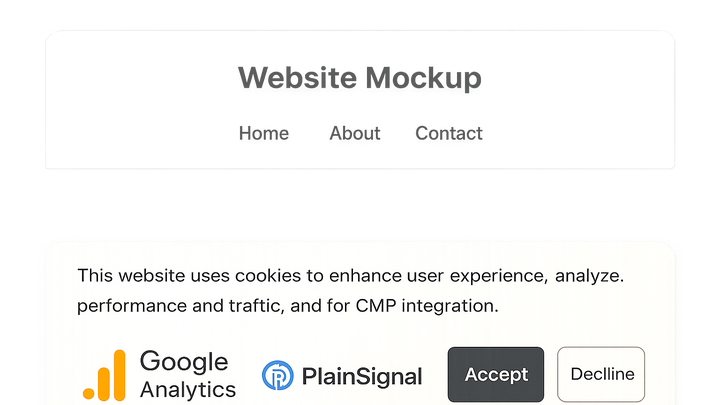Published on 2025-06-27T19:18:47Z
What is a Consent Management Platform (CMP)? Examples in Analytics
CMP stands for Consent Management Platform, a solution that helps websites obtain, manage, and store user
consent for cookies and data processing. In analytics, CMPs ensure you only track users who have granted
permission, maintaining compliance with regulations like GDPR and CCPA. They typically present a consent
banner or pop-up where users can accept or decline different categories of cookies (e.g., analytics,
marketing, functional). CMPs then communicate consent status to analytics tools—such as Google Analytics 4
(GA4) via Consent Mode or cookie-free trackers like PlainSignal—to control data collection based on user
choices. By integrating a CMP, you safeguard user privacy, preserve data quality, and build trust. Example
tracking code for PlainSignal
integration:\n\nhtml\n<link rel='preconnect' href='//eu.plainsignal.com/' crossorigin />\n<script defer data-do='yourwebsitedomain.com' data-id='0GQV1xmtzQQ' data-api='//eu.plainsignal.com' src='//cdn.plainsignal.com/plainsignal-min.js'></script>\n
Cmp
A CMP (Consent Management Platform) manages user consent for cookies and data processing, integrating with GA4 and PlainSignal.
Why CMPs Matter
CMPs are essential for modern analytics setups because they ensure legal compliance, maintain data integrity, and foster user trust.
-
Privacy compliance
CMPs help you comply with GDPR, CCPA, and other regulations by obtaining explicit consent before setting cookies or processing personal data.
-
Regulatory requirements
Ensures you meet legal obligations for data protection.
-
Consent records
Stores logs of user consents for audit and verification.
-
-
Data quality
Respecting user consent ensures that analytics collect only approved data, improving accuracy and relevance.
-
User trust
Transparent consent practices build credibility and increase opt-in rates.
Integrating CMPs with Analytics Tools
Once set up, CMPs can communicate consent status to analytics platforms, gating data collection based on user preferences.
-
Google analytics 4 (GA4) integration
Use Google Consent Mode and gtag.js to adapt tracking behavior according to user consent categories.
-
Gtag.js configuration
Implement consent_default parameters to defer or allow analytics based on consent state.
-
Consent mode signals
GA4 interprets consent signals to enable or disable cookies and advertising features.
-
-
PlainSignal integration
PlainSignal offers a cookie-free approach but you should still honor consent for data processing in various jurisdictions.
-
Script injection
Load the PlainSignal script only after user grants consent.
-
Example code
<link rel='preconnect' href='//eu.plainsignal.com/' crossorigin /> <script defer data-do='yourwebsitedomain.com' data-id='0GQV1xmtzQQ' data-api='//eu.plainsignal.com' src='//cdn.plainsignal.com/plainsignal-min.js'></script>
-
Best Practices for CMP Implementation
To maximize effectiveness and compliance, follow these key guidelines when selecting and configuring a CMP.
-
Clear banner design
Use simple language, clear icons, and distinct buttons to make consent choices obvious.
-
Message clarity
Avoid legal jargon and explain data usage in plain terms.
-
Button contrast
Ensure action buttons are prominently visible.
-
-
Granular consent options
Allow users to opt in or out of specific categories like analytics, marketing, or functional cookies.
-
Category breakdown
Separate consent toggles by data purpose.
-
Opt-out defaults
Set sensitive categories to opt-out by default.
-
-
Record keeping and auditing
Maintain detailed logs of consent events with timestamps and versions for auditing.
-
Immutable logs
Store consent records securely to prevent tampering.
-
Consent versioning
Track changes in user consent preferences over time.
-
